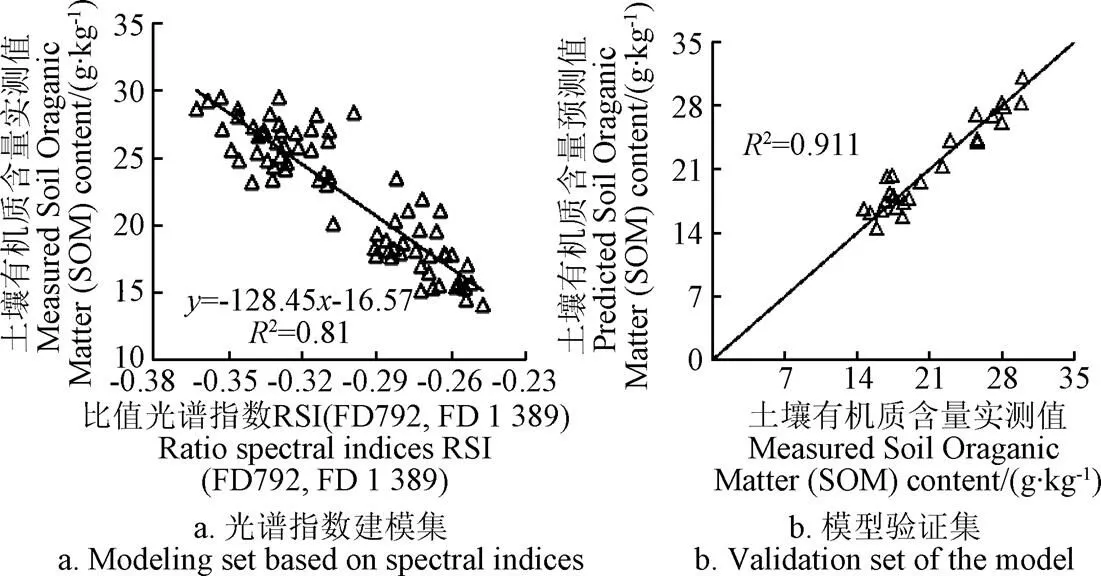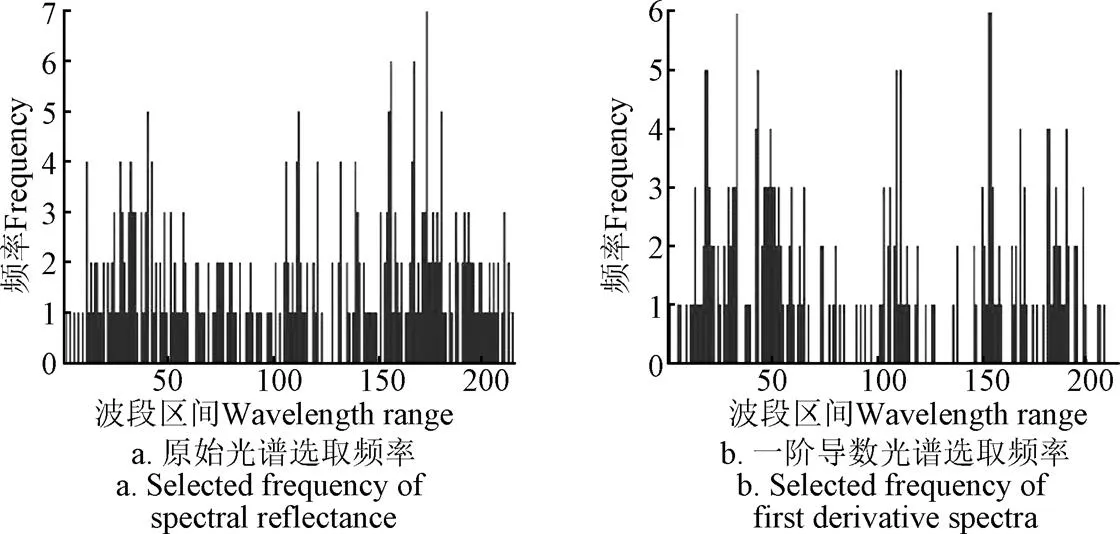砂姜黑土有机质含量高光谱估测模型构建
张娟娟,席 磊,杨向阳,许 鑫,郭 伟,程 涛,马新明,3
砂姜黑土有机质含量高光谱估测模型构建
张娟娟1,2,席 磊1,2,杨向阳2,许 鑫1,2,郭 伟1,2,程 涛2,马新明1,2,3※
(1. 河南粮食作物协同创新中心,郑州 450002;2. 河南农业大学信息与管理科学学院,郑州 450002;3. 河南农业大学农学院,郑州 450002)
为快速估测砂姜黑土有机质含量,该研究以河南省商水县砂姜黑土为对象,采用光谱指数和遗传算法结合支持向量机构建砂姜黑土有机质估测模型。结果表明,以Savitzky-Golay(SG)平滑后的一阶导数光谱792和1 389 nm两波段组合构建的比值指数表现最好,建模集决定系数为0.81。利用独立的样本验证,预测决定系数和均方根误差分别为0.91和1.56 g/kg。而相同样本经遗传算法筛选敏感波段结合支持向量机回归构建的模型以SG平滑的一阶导数光谱表现最好,建模集和验证集决定系数分别为0.95和0.91,均方根误差分别为1.01和1.69 g/kg。基于遗传算法结合支持向量机回归和光谱指数2种方法构建的有机质含量估测模型均表现出较高的精度,前者稍优于后者,可用于对砂姜黑土有机质含量的有效估测。该研究成果可为砂姜黑土有机质含量的快速定量估算提供依据和参考。
土壤;有机质;高光谱;光谱指数;遗传算法;支持向量机;砂姜黑土
0 引 言
土壤有机质作为主要养分,是评估土壤肥力水平的一项重要指标,对作物的生长有着至关重要的作用。目前,土壤有机质分析仍采用室内化学测定的方法,费时费力,时效性差。而高光谱遥感技术由于具有分辨率高,能快速获取大量光谱信息等特点而被广泛用于土壤养分等指标的估测。国内外较多学者对于土壤有机质高光谱估测模型进行了研究,模型的估测精度差异较大。早期学者们采用相关分析法研究不同类型土壤有机质与土壤光谱反射率及不同变换形式的关系,将相关系数高的波长作为土壤有机质的敏感波段,如Gunsaulis等[1]研究表明,土壤有机质含量与红光波段的反射率具有较强的相关性,决定系数可达0.61;卢艳丽等[2]认为东北黑土有机质含量与545~738 nm波段的原始光谱反射率和481~598 nm波段的一阶导数光谱呈极显著负相关,而与816~932 nm和1 039~l 415 nm波段的一阶导数光谱呈极显著正相关性。近年来,多变量回归建模方法逐渐应用于土壤养分的估测中,如Uno等[3]采用主成分分析结合多元线性回归和人工神经网络构建土壤有机质模型。Liu等[4]采用9种建模方案构建了不同土地利用类型土壤有机质的估测模型,估测精度决定系数(Coefficient of Determination,2)最高为0.89。Viscarra等[5]构建了澳大利亚土壤有机碳不同组分含量的估测模型。Ward等[6]利用偏最小二乘法结合多种光谱吸收特征构建了欧洲土地利用及覆盖统计调查(European Land Use/Cover Area Frame Statistical Survey, LUCAS)土壤的有机碳估测模型。国内学者于雷等[7]基于不同方法筛选光谱特征波长变量,结合偏最小二乘法构建汉江平原3种主要土壤类型潮土、水稻土和黄棕壤的光谱估测模型,模型预测决定系数可达0.92。侯艳军等[8]利用多元逐步回归和偏最小二乘法比较了不同形式变换光谱构建的荒漠土壤有机质含量估测模型。林鹏达等[9]采用连续小波变换结合偏最小二乘回归构建吉林省黑土高光谱估测模型,建模精度2最高达到了0.87。张智韬等[10]利用分数阶微分联合支持向量机分类-随机森林模型构建了荒漠土壤有机质含量预测模型,建模决定系数可达0.98。综上所述,已有较多研究采用不同方法构建了土壤有机质含量估测模型,但由于不同土壤类型差异较大,模型的估测精度和实际应用效果仍需进一步研究。
砂姜黑土发育于河湖相沉积物、低洼潮湿和排水不良环境,经前期草甸潜育化过程和后期旱耕熟化过程形成的一种耕作土壤类型,全国面积计有370万hm2左右,主要分布于黄淮海平原南部,其特点是质地黏重,结构性差,难耕难耙[11-13]。以往研究多以多种类型混合土壤作为样本或者单一土壤类型作为建模样本,而土壤的光谱特征受土壤颗粒、结构、养分等多种因素影响。砂姜黑土与潮土、水稻土等差异明显,因此,有必要进一步研究砂姜黑土的高光谱特征,构建其有机质含量高光谱估测模型,为快速精确估测提供依据和技术参考。本研究以商水县砂姜黑土为研究对象,对原始光谱进行预处理,采用光谱指数及遗传算法结合支持向量机构建砂姜黑土有机质高光谱估测模型,以期为砂姜黑土有机质含量的光谱快速估测提供理论依据和技术参考。
1 材料与方法
1.1 土样采集与处理
土壤样品结合河南省商水县国营农场十四分场(33°32′N,114°29′E)设置的小麦氮肥处理试验采集,土壤类型为典型砂姜黑土,采集0~20和>20~40 cm 2个土层,采样时将每个采样点地表植物清除,共采集样本100份。经自然风干之后,用木棒压磨后粗略去除砂砾及植物残体,然后过0.9 mm筛混合均匀,供光谱测试和化学分析使用。
1.2 高光谱数据采集
使用美国ASD FieldSpec 4便携式高光谱仪测量土壤样本的高光谱反射率。该光谱仪测定的波长范围为350~2 500 nm,其中,350~1 000 nm 光谱采样间隔为1.4 nm,光谱分辨率为3 nm;1 000~2 500 nm光谱采样间隔为2 nm,光谱分辨率为10 nm,重采样间隔为1 nm,输出波段数为2 151。整个操作过程在等同于暗室的实验室内进行测定,测定时使用的光源为与仪器配套的功率为1 000 W卤素灯。把适量经处理的过0.9 mm孔径筛的土壤样品倒入盛样皿中,用木棒稍稍压实,使其表面尽量平整。测量时使用的探头视场角为5°,其距离土壤样本表面的距离为30 cm。光源照射方向与竖直方向夹角为30°,测量时每个样品旋转3次,每个角度采集10条光谱反射率曲线,3个方向共有30条光谱曲线,计算30条曲线的平均值作为样本的光谱反射率数据。
1.3 土壤有机质测定
土壤有机质含量采用重铬酸钾-外加热法方法进行测定[14]。土壤样本有机质数据统计特征如表1所示,随机选取75个样本用于建模,其余25个样本用于验证。

表1 土壤有机质含量统计
1.4 数据分析方法
1.4.1 光谱数据预处理
为了减小光谱测定过程中所产生的误差,较准确找出土壤有机质高光谱敏感波段,对土壤样本的原始光谱数据进行预处理,来提高其相关性。Cloutis[15]研究表明,光谱经过低阶导数处理以后,对噪声影响的敏感性有所降低。因此,本研究在建立模型前用Savitzky-Golay(SG)平滑[16]对一阶导数光谱进行预处理,移除噪音对高光谱曲线的影响,降低样本的不均匀性带来的光谱差异。
1.4.2 光谱指数分析
利用350~2 500 nm波段的光谱反射率,构建原始光谱和SG平滑后一阶导数光谱任意两波段组合而成的差值光谱指数(Difference Spectral Indices, DSI)、归一化光谱指数(Normalized Spectral Indices, NSI)和比值光谱指数(Ratio Spectral Indices, RSI),计算如式(1)、式(2)和式(3)所示。
DSI=R1−λ2(1)
NSI=(R1−R2)/(R1+R2)(2)
RSI=R1/R2(3)
式中R1和λ2分别为350~2 500 nm波段范围内任意2个波段的反射率。
1.4.3 遗传算法
遗传算法(Genetic Algorithm, GA)是一种随机优化选择算法,其本质是模拟生物的进化过程,是光谱分析中常用一种变量选择方法[17]。在进行土壤养分信息高光谱的特征波段选择时,GA主要分为编码、选择初始群体、适应度函数的确定、复制、交叉和变异几个主要步骤。在遗传算法挑选波段的过程中,取10 nm为间隔的平均值作为输入,以去除冗余信息,同时兼顾光谱基本特征[18]。
1.4.4 支持向量机
支持向量机(Support Vector Machine, SVM)是一种基于统计学习理论的新型结构化学习算法,专门用来研究有限样本预测的智能学习方法。目前,在处理分类与回归问题时,支持向量机常常被用到,尤其是在对小样本非线性与高维模式分类处理时,更加能展现出其最优的性能。SVM采用R语言软件来实现,使用e1017包的libsvm函数训练支持向量机,核函数使用默认值radial(径向基函数),成本函数cost和gamma选择模型中最佳参数。
1.4.5 模型验证
土壤有机质含量估测模型的精度使用决定系数(Coefficient of Determination,2)和均方根误差(Root Mean Square Error, RMSE)来评价。2和RMSE的计算如式(4)和式(5)所示。


2 结果与分析
2.1 砂姜黑土高光谱特征
图1为不同有机质含量的砂姜黑土高光谱特征曲线。由图1可知,不同土壤有机质含量光谱反射率曲线整体趋势一致,在350~1 350 nm波段内光谱反射率呈单调递增趋势,在可见光区域350~780 nm波段之间,土壤光谱反射率较低,但是增长速度较快,整体光谱曲线的走势较陡;在780~1 900 nm波段之间,土壤光谱的反射率较高,增长速度相对较慢,光谱曲线的走势较为平缓;在1 900~2 100 nm波段之间,土壤光谱的反射率随波长的增加而上升,在2 100 nm附近,曲线的反射率值基本上达到极大值;在2 100~2 500 nm波段之间,土壤光谱的反射率随波长增加呈现下降趋势,均在1 400、1 900和2 200 nm附近处存在明显的水分吸收峰。有机质含量对反射率高低具有一定影响,表现为有机质含量越高,反射率越低,相反,反射率升高。
2.2 基于光谱指数的土壤有机质含量估测
原始光谱反射率(Reflectance,)和SG平滑后一阶导数(First Derivative,FD)2种光谱形式任意两两波段所组成的DSI、NSI和RSI与有机质含量的相关等势图如图2和图3所示。结果显示,2种光谱形式的波段范围组合存在明显的差异。原始光谱与有机质相关性较好的波段主要集中在650、1 500和2 200 nm附近处,其中DSI(995,1 911)、NSI(2 067,2 208)和RSI(1 037,1 908)分别是3种光谱组合形式中拟合程度最好的组合。SG平滑后一阶导数光谱与有机质相关性较好的波段主要集中在1 350~2 000 nm与600~1 000 nm组合波段区域,其中DSI(FD792, FD1 420)、NSI(FD792,FD1 389)和RSI(FD792, FD1 389)分别是3种光谱组合形式中拟合程度最好的组合。

图1 不同有机质含量的砂姜黑土反射光谱特征

注:图中数字为土壤有机质含量与原始光谱波段组合指数的决定系数(R2)。

注:图中数字为土壤有机质含量与SG平滑后一阶导数波段组合指数的决定系数(R2)。
对2种光谱形式中表现最好的光谱参数与土壤有机质含量进行线性建模,并利用独立的数据进行验证,结果如表2所示。基于NSI(2 067,2 208)、DSI(FD792, FD1 420)、NSI(FD792, FD1 389)和RSI(FD792, FD1 389)构建的模型的决定系数均达到了0.8以上,其次为RSI(1 037,1 908)、构建的模型,建模决定系数为0.78,而由DSI(995,1 911)构建的模型,表现较差。经SG平滑的一阶导数构建的比值光谱指数模型建模决定系数为0.81,预测决定系数达到0.91,RMSE分别为2.03和1.56,显示该模型具有较高的预测精度和稳定性。图4为基于RSI(FD792, FD1 389)的建模和验证散点图。

表2 土壤有机质光谱指数模型

图4 土壤有机质与SG平滑后的一阶导数比值光谱指数RSI(FD792, FD1 389)之间的关系及模型验证
2.3 基于支持向量机的土壤有机质含量估测
2.3.1 基于遗传算法的土壤有机质波段选择
将建模集75个土壤样本作为初始群体,每条染色体的长度是215。算法的最大运行代数设定为50,最后结果按波段选择的频率和组分的贡献率由大到小排列,将频率排名在前10的光谱波段作为建模波段区间。遗传算法迭代过程选择原始光谱和经过SG平滑后的一阶导数2种光谱形式的有机质含量建模波长频率的结果如图5所示。选取原始光谱有机质建模波长的敏感波段区间12、27、32、40、112、155、156、167、173和180,对应光谱的原始区间为461~470、611~620、661~670、741~750、1 461~1 470、1 891~1 900、1 901~1 910、2 011~2 020、2 071~2 080和2 141~2 150 nm。选取经过SG平滑后一阶导数的有机质建模波长的敏感波段区间18、19、33、42、43、49、109、111、153和154,对应光谱的原始区间为521~530、531~540、671~680、761~770、771~780、831~840、1 431~1 440、1 451~1 460、1 871~1 880和1 881~1 890 nm。

图5 用遗传算法选择原始光谱和SG平滑后一阶导数光谱土壤有机质含量建模波长频率图
2.3.2 基于支持向量机的土壤有机质估测模型
将遗传算法筛选出的敏感波段作为支持向量机回归的输入值,以土壤有机质的含量作为输出,结果如表3所示。基于支持向量机构建的模型建模决定系数均在0.9以上,其中,基于遗传算法筛选的SG平滑后一阶导数的敏感波段作为输入构建的有机质模型建模(图6a)及验证(图6b)结果表现最好,其决定系数2分别为0.95和0.91,均方根误差RMSE分别为1.01和1.69,表明模型具有较好的预测能力。

表3 基于支持向量机的土壤有机质建模与验证结果

图6 基于支持向量机的土壤有机质含量建模及验证
3 讨 论
关于土壤有机质的光谱反演已有较多研究,由于土壤组成的复杂性以及颗粒等因素影响,现有研究还没统一的结论。已有研究目标样本大概分2种,一种是获取多种类型的土壤,刘焕军等[19]研究表明模型在预测不同类型土壤时精度会下降,另一部分研究对单一的土壤类型进行研究,如黑土、红壤、潮土、棕壤、水稻土等[2, 9, 20-23],但目前关于砂姜黑土的光谱特征、敏感波段选择及模型方面还报道较少。本研究通过系统分析砂姜黑土的高光谱特征,结果显示,砂姜黑土土壤的光谱曲线趋势与其他类型土壤基本一致,除水分吸收峰外,整体表现平缓。通过构建原始光谱及SG平滑后的一阶导数光谱两两波段组合而成的光谱指数,结果显示,与原始光谱最好敏感区域主要位于650、1 500和2 200 nm附近,一阶导数最好的敏感区域主要位于790和1 400 nm附近,结果与卢艳丽等[2]、洪永胜等[24]、祁亚琴等[25]研究稍有差别。同时本研究还利用遗传算法筛选了土壤有机质的敏感区域作为支持向量机建模方法的输入,由于遗传算法利用偏最小二乘回归中的交叉性均方根误差(Root Mean Square Error of Cross Validation, RMSECV)和决定系数2作为适应度函数,筛选的区域为多次运算之后选中次数多的波段,部分区域与光谱指数方法提取一致。但由于遗传算法是一种自适应的全局的概率搜索算法,借鉴生物界自然选择和遗传机制,利用选择、交换和突变等算子的操作,随着不断的遗传迭代,最终达到了最优的结果[26],因此可能会存在差异。
光谱指数是在植被监测中常用的方法,在土壤养分估测中也有应用[10,27]。本研究构建的砂姜黑土有机质含量估测光谱指数RSI(FD792, FD1 389)在现有研究样本的估测中具有较高的精度,但与张娟娟等[27]前期研究提取的参数具有差异,可能是由于不同类型土壤质地、组成等不同对光谱特征有一定影响。近年来,支持向量机方法在光谱模型构建和参数反演方面表现出较强的优势[28],在本研究中,将遗传算法提取的敏感波段作为输入,采用支持向量机构建的模型建模决定系数和预测决定系数均达到0.9以上,要高于采用光谱指数建立的模型精度,与前人构建的模型精度相比,也要略高,如刘焕军等[19]利用多元统计方法构建了东北黑土有机质估测模型,建模和验证精度分别为0.94和0.90,于雷等[29]利用偏最小二乘方法构建了江汉平原公安县土壤的有机质估测模型,建模和验证精度分别为0.89和0.84,说明该方法和所构建模型可能更适用于有机质含量的光谱预测。因此,本研究构建的RSI(FD792, FD1 389)和支持向量机模型均可用于砂姜黑土的有效估测,光谱指数所用到的2个波段同时可以为便携式光谱仪的研发提供支持。
4 结 论
在系统研究砂姜黑土光谱特征的基础上,采用光谱指数和支持向量机2种方法构建了土壤有机质的光谱估测模型,结果表明,基于比值光谱指数RSI(FD792,FD1 389)构建的模型建模和预测决定系数均达到0.8以上,而遗传算法结合支持向量机构建的模型建模集精度高于前者,建模集和预测集决定系数均在0.9以上,2种模型均可用于砂姜黑土有机质的有效估测。
[1]Gunsaulis F R, Kocher M F, Griffis C L. Surface structure effects on close-range reflectance as a function of soil organic matter content[J]. American Society of Agricultural Engineer, 1991, 34(2): 641-649.
[2]卢艳丽,白由路,杨俐苹,等. 高光谱的土壤有机质含量预测模型的建立与评价[J]. 中国农业科学,2007,40(9):1989-1995.
Lu Yanli, Bai Youlu, Yang Liping, et al. Prediction and validation of soil organic matter content based on hyper spectrum[J]. Scientia Agricultura Sinica, 2007, 40(9): 1989-1995. (in Chinese with English abstract)
[3]Uno Y, Prasher S O, Patel R M, et al. Development of field-scale soil organic matter content estimation models in Eastern Canada using airborne hyperspectral imagery[J]. Canadian Biosystems Engineering, 2005, 47: 9-14.
[4]Liu Yaolin, Jiang Qinhu, Fei Teng, et al. Transferability of a visible and near-infrared model for soil organic matter estimation in riparian landscapes[J]. Remote Sensing, 2014, 6(5): 4305-4322.
[5]Viscarra Rossel R A, Hicks W S. Soil organic carbon and its fractions estimated by visible-near infrared transfer functions[J]. European Journal of Soil Science, 2015, 66(3): 438-450.
[6]Ward K J, Chabrillat S, Neumann C, et al. A remote sensing adapted approach for soil organic carbon prediction based on the spectrally clustered LUCAS soil database[J]. Geoderma, 2019, 353: 297-307.
[7]于雷,洪永胜,周勇,等. 高光谱估算土壤有机质含量的波长变量筛选方法[J]. 农业工程学报,2016,32(13):95-102.
Yu Lei, Hong Yongsheng, Zhou Yong, et al. Wavelength variable selection methods for estimation of soil organic matter content using hyperspectral technique[J]. Transactions of the Chinese Society of Agricultural Engineering (Transactions of the CSAE), 2016, 32(13): 95-102. (in Chinese with English abstract)
[8]侯艳军,塔西甫拉提·特依拜,买买提·沙吾提,等. 荒漠土壤有机质含量高光谱估算模型[J]. 农业工程学报,2014,30(16):113-120.
Hou Yanjun, Tashpolat Tiyip, Mamat Sawut, et al. Estimation model of desert soil organic matter content using hyperspectral data[J]. Transactions of the Chinese Society of Agricultural Engineering (Transactions of the CSAE), 2014, 30(16): 113-120. (in Chinese with English abstract)
[9]林鹏达,佟志军,张继权,等. 基于CWT的黑土有机质含量野外高光谱反演模型[J]. 水土保持研究,2018,25(2):46-52,57.
Lin Pengda, Tong Zhijun, Zhang Jiquan, et al. Inversion of black boil organic matter content with field hyperspectral reflectance based on continuous wavelet transformation[J]. Research of Soil and Water Conservation, 2018, 25(2): 46-52, 57. (in Chinese with English abstract)
[10]张智韬,劳聪聪,王海峰,等. 基于FOD和SVMDA-RF的土壤有机质含量高光谱预测[J]. 农业机械学报,2020,51(1):156-167. Zhang Zhitao, Lao Congcong, Wang Haifeng, et al. Estimation of desert soil organic matter through hyper spectra based on fractional-order derivatives and SVMDA-RF[J]. Transactions of the Chinese Society for Agricultural Machinery, 2020, 51(1): 156-167. (in Chinese with English abstract)
[11]宗玉统. 砂姜黑土的物理障碍因子及其改良[D]. 杭州:浙江大学,2013.
Zong Yutong. The Physical Obstacle Factors of Shajiang Black Soils and Its Improvement[D]. Hangzhou: Zhejiang University, 2013. (in Chinese with English abstract)
[12]王玥凯,郭自春,张中彬,等. 不同耕作方式对砂姜黑土物理性质和玉米生长的影响[J]. 土壤学报,2019,56(6):1370-1380.
Wang Yukai, Guo Zichun, Zhang Zhongbin, et al. Effect of tillage practices on soil physical properties and maize growth in Shajiang black soil (Vertosol)[J]. Acta Pedologica Sinica, 2019, 56(6): 1370-1380. (in Chinese with English abstract)
[13]刘哲,韩霁昌,孙增慧,等. δ13C法研究砂姜黑土添加秸秆后团聚体有机碳变化规律[J]. 农业工程学报,2017,33(14):179-187.
Liu Zhe, Han Jichang, Sun Zenghui, et al. Change law of organic carbon in lime concretion black soil aggregates with application of straw by δ13C method[J]. Transactions of the Chinese Society of Agricultural Engineering (Transactions of the CSAE), 2017, 33(14): 179-187. (in Chinese with English abstract)
[14]鲍士旦. 土壤农化分析[M]. 北京:中国农业出版社,1999:30-34.
[15]Cloutis E A. Hyperspectral geological remote sensing: evaluation of analytical techniques[J]. International Journal of Remote Sensing, 1996, 17(12): 2215-2242.
[16]Savitzky A, Golay M J E. Smoothing and differentiation of data by simplified least squares procedures[J]. Analytical Chemistry, 1964, 36(8): 1627-l639.
[17]祝诗平,王一鸣,张小超,等. 基于遗传算法的近红外光谱谱区选择方法[J]. 农业机械学报,2004,35(5):152-156.
Zhu Shiping, Wang Yiming, Zhang Xiachao, et al. Region selection method of near infrared spectrum based on genetic algorithm[J]. Transaction of the Chinese Society for Agricultural Machinery, 2004, 35(5): 152-156. (in Chinese with English abstract)
[18]Thomas K, Stefan S. Estimate of heavy metal contamination in soils after a mining accident using reflectance spectroscopy[J]. Environmental Science & Technology, 2002, 36(12): 2742-2747.
[19]刘焕军,张柏,赵军,等. 黑土有机质含量高光谱模型研究[J]. 土壤学报,2007,44(1):27-32.
Liu Huanjun, Zhang Bai, Zhao Jun, et al. Spectral models for prediction of organic matter in black soil[J]. Acta Pedologica Sinica, 2007, 44(1): 27-32. (in Chinese with English abstract)
[20]赵小敏,杨梅花. 江西省红壤地区主要土壤类型的高光谱特性研究[J]. 土壤学报,2018,55(1):31-42.
Zhao Xiaomin, Yang Meihua. Hyper-spectral characteristics of major types of soils in red soil region of Jiangxi province, China[J]. Acta Pedologica Sinica, 2018, 55(1): 31-42. (in Chinese with English abstract)
[21]邹慧敏,李西灿,尚璇,等. 粒子群优化神经网络的土壤有机质高光谱估测[J]. 测绘科学,2019,44(5):146-150,170.
Zou Huimin, Li Xican, Shang Xuan, et al. Hyperspectral estimation of soil organic matter based on particle swarm optimization neural network[J]. Science of Surveying and Mapping, 2019, 44(5): 146-150, 170. (in Chinese with English abstract)
[22]朱亚星,于雷,洪永胜,等. 土壤有机质高光谱特征与波长变量优选方法[J]. 中国农业科学,2017,50(22):4325-4337.
Zhu Yaxing, Yu Lei, Hong Yongsheng, et al. Hyperspectral features and wavelength variables selection methods of soil organic matter[J]. Scientia Agricultura Sinica, 2017, 50(22): 4325-4337. (in Chinese with English abstract)
[23]周清,周斌,张杨珠,等. 水稻土SOM含量高光谱模型的母质差异性研究[J]. 科技通报,2004,20(6):471-475.
Zhou Qing, Zhou Bin, Zhang Yangzhu, et al. The difference of SOM content hyperspectral models of paddy soils derived from different parent material[J]. Bulletin of Science and Technology, 2004, 20(6): 471-475. (in Chinese with English abstract)
[24]洪永胜,朱亚星,苏学平,等. 高光谱技术联合归一化光谱指数估算土壤有机质含量[J]. 光谱学与光谱分析,2017,37(11):3537-3542.
Hong Yongsheng, Zhu Yaxing, Su Xueping, et al. Estimation of soil organic matter content using hyperspectral techniques combined with normalized difference spectral index[J]. Spectroscopy and Spectral Analysis, 2017, 37(11): 3537-3542. (in Chinese with English abstract)
[25]祁亚琴,吕新,邵玉林,等. 基于高光谱数据的土壤有机质含量预测研究[J]. 新疆农业科学,2014,51(7):1300-1305.
Qi Yaqin, Lyu Xin, Shao Yulin, et al. Study on soil organic matter content estimated model by hyperspectral remote sensing data[J]. Xinjiang Agricultural Sciences, 2014, 51(7): 1300-1305. (in Chinese with English abstract)
[26]刘辉军,林敏,施秧,等. 遗传算法在绿茶叶近红外光谱分析中波长选择的应用[J]. 理化检验:化学分册,2008,44(3):249-251.
Liu Huijun, Lin Min, Shi Yang, et al. Application of genetic algorithm to wavelength selection in near infrared spectrometric analysis of green tea[J]. Physical Testing & Chemical Analysis: Chemical Analysis, 2008, 44(3): 249-251. (in Chinese with English abstract)
[27]张娟娟,田永超,朱艳,等. 不同类型土壤的光谱特征及其有机质含量预测[J]. 中国农业科学,2009,42(9):3154-3163.
Zhang Juanjuan, Tian Yongchao, Zhu Yan, et al. Spectral characteristics and estimation of organic matter contents of different soil types[J]. Scientia Agricultura Sinica, 2009, 42(9): 3154-3163. (in Chinese with English abstract)
[28]陈思明,毛艳玲,邹小兴,等. 基于不同建模方法的湿地土壤有机质含量多光谱反演[J]. 土壤通报,2018,49(1):16-22.
Chen Siming, Mao Yanling, Zou Xiaoxing, et al. Comparative assessment of different methods for estimating soil organic matter content with multispectral data in wetland[J]. Chinese Journal of Soil Science, 2018, 49(1): 16-22. (in Chinese with English abstract)
[29]于雷,洪永胜,耿雷,等. 基于偏最小二乘回归的土壤有机质含量高光谱估算[J]. 农业工程学报,2015,31(14):103-109.
Yu Lei, Hong Yongsheng, Geng Lei, et al. Hyperspectral estimation of soil organic matter content based on partial least squares regression[J]. Transactions of the Chinese Society of Agricultural Engineering (Transactions of the CSAE), 2015, 31(14): 103-109. (in Chinese with English abstract)
Construction of hyperspectral estimation model for organic matter content in Shajiang black soil
Zhang Juanjuan1,2, Xi Lei1,2, Yang Xiangyang2, Xu Xin1,2,Guo Wei1,2, Cheng Tao2, Ma Xinming1,2,3※
(1.450002; 2.450002; 3.450002)
The objectives of this study were to estimate models for organic matter content of Shajiang black soil, which provided a basis and reference for rapid quantitative estimation of soil organic matter. In this study, Shajiang black soil in Shangshui county of Henan province was collected, the organic matter content and hyperspectral reflectance of Shajiang black soil were analyzed and tested simultaneously, and hyperspectral characteristics of Shajiang black soil were studied. Then, the original reflectance was converted to the first derivative spectral with Savitzky-Golay (SG) smoothing. Difference Spectral Indices (DSI), Normalized Spectral Indices (NSI), and Ratio Spectral Indices (RSI) of these two forms spectral were calculated from all available combinations with the reflectance of two random bands between 350 and 2 500 nm, and correlated to soil organic matter content, then the key spectral index and quantitative models for organic matter content of Shajiang black soil were developed. On the other hand, the sensitive bands of soil organic matter were extracted with the Genetic Algorithm (GA) and quantitative models of soil organic matter using Support Vector Machine (SVM) were established. The results showed that the spectral reflectance of Shajiang black soil under different organic matter levels had the same trend, and organic matter levels had a certain influence on reflectance. Organic matter content was higher, the reflectance would be lower, and on the contrary, the reflectance would be higher. The bands with good correlation between organic matter content and DSI, NSI, RSI based on the original reflectance were mainly concentrated near 650, 1 500 and 2 200 nm, DSI composed of reflectance of 995 and 1 911 nm, NSI composed of reflectance of 2 067 and 2 208 nm, RSI composed of reflectance of 1 037 and 1 908 nm had the better fitting degree. The bands with good correlation between organic matter content and DSI, NSI, RSI based on the first derivative spectral after SG smoothing were mainly concentrated in the combined band region of 1 350-2 000 and 600-1 000 nm, DSI composed of the first derivative of 792 and 1 420 nm, NSI composed of the first derivative of 792 and 1 389 nm, RSI composed of the first derivative of 792 and 1 389 nm had the better fitting degree. For all the spectral indices that were calculated, RSI composed of the first derivative of 792 nm and 1 389 nm gave a better prediction performance, the coefficient of determination was 0.81. Testing of the monitoring models within dependent data indicated that the coefficient of determination and root mean square error of validation were 0.91 and 1.56, respectively. In addition, the sensitive band ranges based on the original reflectance which selected by GA were 461-470, 611-620, 661-670, 741-750, 1 461-1 470, 1 891-1 900, 1 901-1 910, 2 011-2 020, 2 071-2 080 and 2 141-2 150 nm, and the sensitive band ranges based on the first derivative with SG smoothing which selected by GA were 521-530, 531-540, 671-680, 761-770, 771-780, 831-840, 1 431-1 440, 1 451-1 460, 1 871-1 880 and 1 881-1 890 nm for the same sample. The bands of the first derivative with SG smoothing mentioned above were used as input to SVR, and the quantitative model of soil organic matter performed the best. The coefficient of determination and root mean square error of modeling and validation was 0.95 and 0.91, 1.01, and 1.69, respectively. The compared quantitative model with Support Vector Machine, RSI composed of the first derivative of 792 and 1 389 nm had a little lower modeling accuracy, but it could meet the need for estimating the organic matter content of Shajiang black soil. It was concluded that both methods based on RSI composed of the first derivative of 792 and 1 389 nm and SVM can estimate organic matter content of Shajiang black soil accurately.
soil; organic matter; hyperspectral; spectral index; genetic algorithm; support vector machine; Shajiang black soil
张娟娟,席 磊,杨向阳,等. 砂姜黑土有机质含量高光谱估测模型构建[J]. 农业工程学报,2020,36(17):135-141.doi:10.11975/j.issn.1002-6819.2020.17.016 http://www.tcsae.org
Zhang Juanjuan, Xi Lei, Yang Xiangyang, et al. Construction of hyperspectral estimation model for organic matter content in Shajiang black soil[J]. Transactions of the Chinese Society of Agricultural Engineering (Transactions of the CSAE), 2020, 36(17): 135-141. (in Chinese with English abstract) doi:10.11975/j.issn.1002-6819.2020.17.016 http://www.tcsae.org
2020-03-16
2020-05-06
国家重点研发计划项目(2016YFD0300609);河南省科技攻关项目(192102110012);河南省现代农业(小麦)产业技术体系项目(S2010-01-G04)
张娟娟,博士,副教授,主要从事农业遥感监测研究。Email:zhangjuan_2003@126.com
马新明,博士,教授,主要从农业信息化研究。Email:xinmingma@126.com
10.11975/j.issn.1002-6819.2020.17.016
S153.6
A
1002-6819(2020)-17-0135-07

